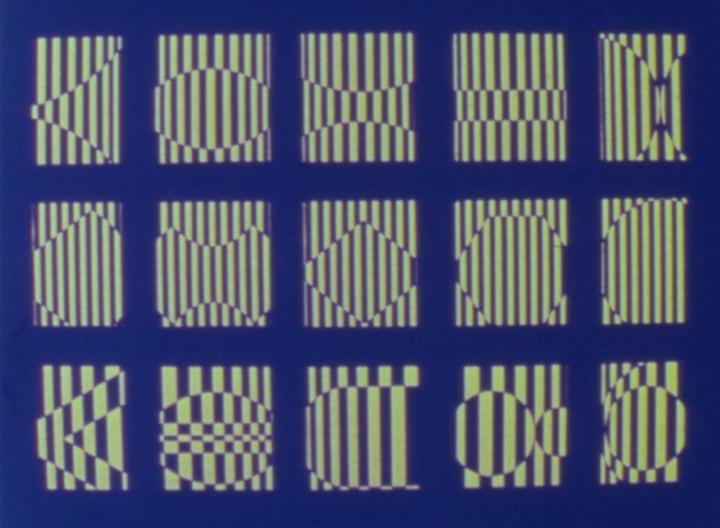In Neuron I have used unconventional filmmaking techniques to explore certain perceptual and acoustical anomalies. It was not my intention to create gimmickry or “effects" with this approach, but rather to develop techniques that would contribute to a personal and expressive form of animated film.
By using the single-frame technique, certain kinds of strobing perceptual phenomena can be mechanically diagrammed in time to produce unusual filmic color structures. These structures have their own synthetic quality — a luminous appearance — which cannot be produced in other art forms. In Neuron I basically used two techniques to achieve these effects: (1) color afterimage, an illusion produced from animated black-and-white patterns, and (2) optical color mixture, a form of temporal pointillism.
The after-image effect used in Neuron to optically generate illusory color is based on a phenomenon called Benham’s Top. The principle of Benham’s Top is usually demonstrated by a rotating disk which is covered with a specially designed black-and-white pattern. Changing the speeds of the disk will cause varying frequencies of flickering white light to generate a wide range of colors. The single-frame process, like the rotating disk, can also cause retinal changes in sensitivity which will produce the illusion of color.
My approach to optical color mixture in Neuron is based on the same phenomenon as pointillist painting, but with one important difference. In a pointillist painting colors are placed next to each other on a static two- dimensional canvas. Essentially the pointillist technique consists of juxtaposing small brush strokes of separate hues so that when viewed they are retinally fused into a single color. By using the technique of animation, optical color mixture can be achieved by organizing hues on separate frames in linear time. These individual color frames, when frenetically animated, appear to co-exist simultaneously in the same frame. The result of this temporal structure is a pulsating, multicolored image.
To unify Neuron conceptually, the sound track as well as the picture track employs graphically manipulated patterns. A portion of the sound at the end of the film was physically altered by applying pieces of self- adhesive Zipatone (line screens used by commercial artists) directly to the optical track. The graphic patterns on this material — composed of varying densities of evenly spaced horizontal lines — change the pitch of the repeated rhythm which is heard throughout Neuron. This change of pitch, therefore, is caused by a purely visual modification and does not originate from a sonic or acoustical source.
Notes taken from Robert Russett: A retrospective survey, University Art Museum, University of Southwestern Louisiana, 1989.
Year:
Country:
References:
External links:
- Post about the restoration process of Neuron, by Mark Toscano.




